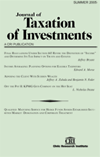Linking Tax and Economic Aspects of Convertible Financial Instruments
Author: James R. Hamill.; Joel S. Sternberg.
Source: Volume 23, Number 03, Spring 2006 , pp.232-245(14)

< previous article |next article > |return to table of contents
Abstract:
A variety of convertible financial instruments exist in the financial marketplace, created principally to satisfy the economic needs of investors, corporations and their shareholders, and employers and employees. Federal tax laws typically provide for a specified treatment depending on the status of an instrument as debt or equity and the nature of the transaction in which the financial instrument is being used. The hybrid nature of a convertible instrument confounds a determination of the appropriate tax treatment of use of a convertible, often leading to a substance-overform approach adopted by the Congress, the IRS, or the courts. To the extent the tax law has a clearly developed policy for the taxation of a particular type of financial instrument, the parties to a convertible instrument must seek to match the economics of their arrangement with this underlying policy to reach an appropriate conclusion regarding the tax treatment.Keywords:
Affiliations:
1: University of New Mexico; 2: Clark University.